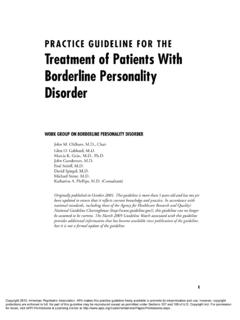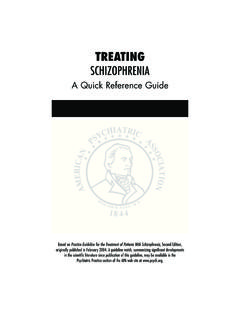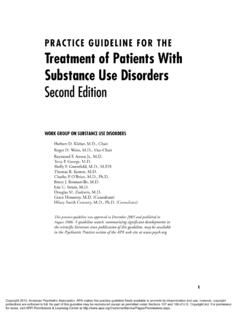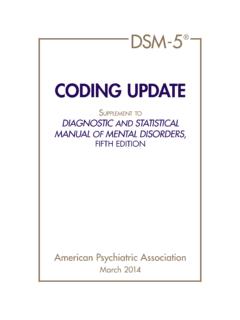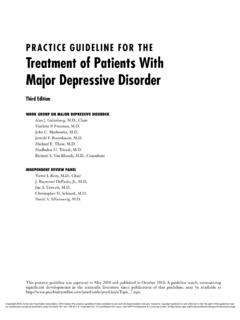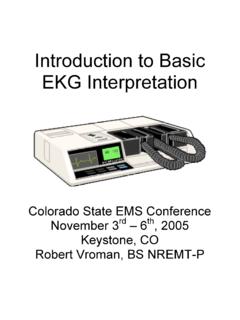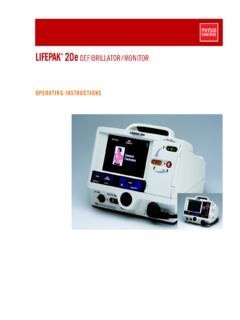Transcription of TREATING EATING DISORDERS - Psychiatry
1 Based on Practice Guideline for the Treatment of Patients With EATING DISORDERS ,Third Edition,originally published in July 2006. A guideline watch, summarizing significant developments in the scientific literature since publication of this guideline, may be available in the Psychiatric Practice section of the APA web site at EATING DISORDERSA Quick Reference GuideAmerican Psychiatric Association Steering Committee on Practice GuidelinesJohn S. McIntyre, , ChairSara C. Charles, , Vice-ChairDaniel J. Anzia, A. Cook, T. Finnerty, R. Johnson, E. Nininger, Summergrad, M. Woods, , Yager, and Component LiaisonsRobert Pyles, (Area I)C. Deborah Cross, (Area II)Roger Peele, (Area III)Daniel J. Anzia, (Area IV)John P. D. Shemo, (Area V)Lawrence Lurie, (Area VI)R. Dale Walker, (Area VII)Mary Ann Barnovitz, Hafter Gray, Saxena, Tonnu, Editors, Quick Reference GuidesMichael B.
2 First, J. Fochtmann, Kunkle, , Senior Program ManagerAmy B. Albert, , Assistant Project ManagerClaudia Hart, Director, Department of Quality Improvement and Psychiatric ServicesDarrel A. Regier, , , Director, Division of ResearchStatement of IntentThe Practice Guidelines and the Quick Reference Guides are not intended to beconstrued or to serve as a standard of medical care. Standards of medical care aredetermined on the basis of all clinical data available for an individual patient andare subject to change as scientific knowledge and technology advance and practicepatterns evolve. These parameters of practice should be considered guidelines to them will not ensure a successful outcome for every individual, norshould they be interpreted as including all proper methods of care or excludingother acceptable methods of care aimed at the same results.
3 The ultimate judg-ment regarding a particular clinical procedure or treatment plan must be made bythe psychiatrist in light of the clinical data presented by the patient and the diag-nostic and treatment options development of the APA Practice Guidelines and Quick Reference Guideshas not been financially supported by any commercial organization. For moredetail, see APA s Practice Guideline Development Process, available as an appen-dix to the compendium of APA practice guidelines, published by APPI, and onlineat Treatment Goals .. Treatment Setting ..2392. Anorexia Nervosa ..242a. Nutritional Rehabilitation ..242b. Psychosocialtreatments ..243c. Medications ..2453. Bulimia Nervosa ..247a. NutritionalRehabilitation ..247b. Psychosocial treatments ..247c. Medications ..2504. EATING DISORDERS Not Otherwise Specified.
4 251a. SubsyndromalEating DISORDERS ..251b. Binge-EatingDisorder ..252 TREATINGEATING DISORDERS224 OUTLINEA. Psychiatric Management Establish and maintain a therapeutic alliance..225 Collaborate with other clinicians..225 Assess and monitor eatingdisorder symptoms . Ensure that the patient s general medical status is assessed and monitored ..227 Assess and monitor thepatient s psychiatric status, including co-occurring conditions and Assess family issues and enlist family Provide education about the patient s EATING disorder and its treatment ..236 TREATINGEATING DISORDERS 225A. Psychiatric ManagementEstablish and maintain a therapeutic alliance. Enhance development of the alliance through empathic commentsand behaviors, positive regard, reassurance, and support. Recognize and acknowledge anxieties that patients with anorexianervosa have about gaining weight.
5 Be aware that many patients may withhold information about theirbehaviors because of shame. Set clear boundaries. Be aware of countertransference reactions. Adapt and modify therapeutic strategies as the disorder and thetherapeutic alliance change over with other clinicians. Provide and/or coordinate care. Collaborate with other individuals who are involved in the patient streatment, including other physicians, registered dietitians, mentalhealth professionals, and school personnel. Consult with other physician specialists and dentists. Educate and supervise inexperienced the process of assessment, diagnosis, and formulation andimplementation of a treatment plan, the following principles of psychiatricmanagement should be kept in mind: TREATINGEATING DISORDERS226A. Psychiatric Management (continued)Assess and monitor EATING disorder symptoms and behaviors.
6 Use DSM-IV-TR criteria to guide diagnosis and identification oftarget symptoms and behaviors. Obtain history of previous episodes of EATING disorder, includingprevious treatment response . Assess specific EATING -related behaviors by obtaining a detailed report of food intake during a single day, observing the patient during a meal, and recording food and/or fluid intake and output as part of nutritional management. Consider the use of formal measures ( , semistructuredinterviews, rating scales, self-report questionnaires). Assess related psychological symptoms ( , obsessional thoughtsrelated to weight, shape, and EATING ). Explore the patient s understanding of how the illness developedand the effects of interpersonal issues on onset, including aspectsof sexual history and psychological, physical, or sexual abuse.
7 Identify stressors that exacerbate the symptoms of the eatingdisorder. Identify relevant psychodynamic and interpersonal conflicts. Determine the patient s insight into the presence of the disorder andthe patient s motivation for DISORDERS 227 Ensure that the patient s general medical status is assessed andmonitored. Ensure that a physical examination is conducted by a physicianknowledgeable about EATING DISORDERS : Vital signs Weight and height, including calculation of BMI Physical and sexual growth and development Cardiovascular system, including evidence of dehydration, cardiac arrhythmias, or congestive heart failure Lanugo Salivary gland enlargement Russell s sign (scarring on dorsum of hand) Muscular irritability or weakness Evidence of self-injurious behaviors Review dental examination results.
8 Conduct laboratory analyses, as indicated. For laboratoryassessments and their patient indications, see Table 1, p. 228. For commonly found signs, symptoms, and associated laboratoryabnormalities, see Table 2, p. 230. TREATINGEATING DISORDERS228 TABLE Assessments for Patients With EATING DisordersAssessmentPatient IndicationBasic analysesAll patients with EATING disordersBlood chemistry studiesSerum electrolytesBlood urea nitrogen Serum creatinine (interpretations must incorporate assessments of weight)Thyroid-stimulating hormone test; if indicated, free T4, T3 Complete blood count including differentialErythrocyte sedimentation rateAspartate aminotransferase, alanine aminotransferase, alkaline phosphataseUrinalysisAdditional analysesMalnourished and severely symptomatic Complement component 3apatients (Serum magnesium should be Blood chemistry studiesobtained prior to administering certain Serum calciummedications if QTc is prolonged.)
9 BSerum magnesiumSerum phosphorusSerum ferritinElectrocardiogram24-hour urine for creatinine clearancecOsteopenia and osteoporosis Patients amenorrheic for >6 monthsassessmentsDual-energy X-ray absorptiometrySerum estradiol in female patientsSerum testosterone in male patientsTREATINGEATING DISORDERS 229 TABLE Assessments for Patients With EATING DISORDERS (continued)AssessmentPatient IndicationNonroutine assessmentsToxicology screenPatients with suspected substance use, particularly those with anorexia nervosa, binge/purge subtype, or for patients with bulimia nervosaSerum amylase (fractionated for Patients with suspected surreptitious salivary gland isoenzyme if vomitingavailable to rule out pancreatic involvement)Serum luteinizing hormone, follicle-Patients with persistent amenorrhea but stimulating hormone, -human who are normal weightchorionic gonadotropin, prolactinBrain magnetic resonance imaging, Patients with significant cognitive deficits, computed tomographyother neurological soft signs, unremitting course, or other atypical featuresStool for guaiac Patients with suspected gastrointestinal bleedingStool or urine for bisacodyl, emodin, Patients with suspected laxative abusealoe-emodin, rheinaSome experts recommend the routine use of complement component 3 as a sensitive marker that may indicatenutritional deficiencies even when other laboratory test results are apparently in the normal hospital refeeding, it is recommended that serum potassium, magnesium.
10 And phosphorus levels bedetermined daily for 5 days and thereafter at least three times/week for 3 clearance should be calculated with equations that involve body surface using assessments of heightand weight. TREATINGEATING DISORDERS230 TABLE Complications of EATING DISORDERS Organ SystemSigns and SymptomsAssociated Laboratory AbnormalitiesWhole bodyLow body weight, dehydration, Weight:Low weight and BMIhypothermia, cachexia, weakness and Anthropometrics:Low body fat percentage bylassitude increase with degree of malnutritionanthropometrics or underwater weighingaCardiovascular and Weakness; faintness; dizziness; orthostatic ECG:Bradycardia in AN; ST-T wave peripheral vascularhypotension; shortness of breath; chest pain; abnormalities in AN and with hypokalemia;palpitations; arrhythmias; bradycardia; increased PR interval and first-degree heartweak irregular pulse; cold extremities; block in AN; QTc prolongationbin AN andacrocyanosiswith hypokalemia; QT dispersion correlated with weight loss.



